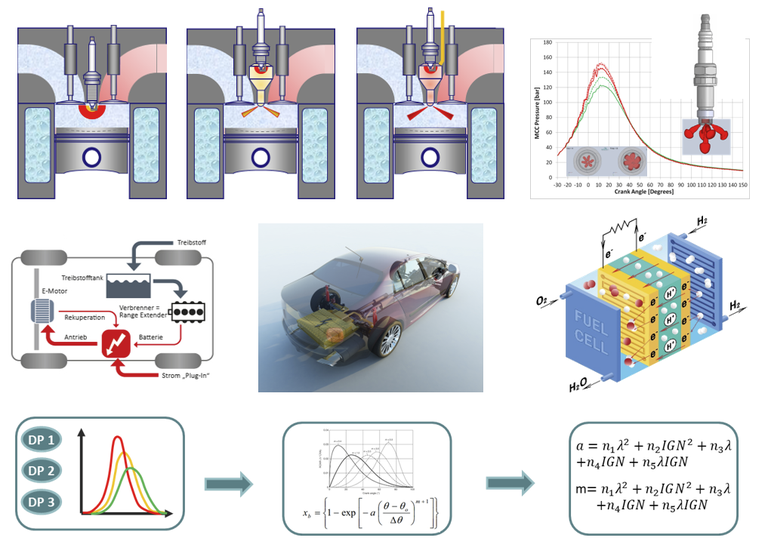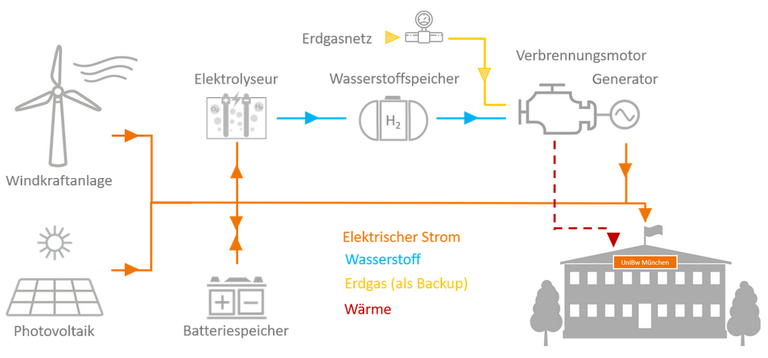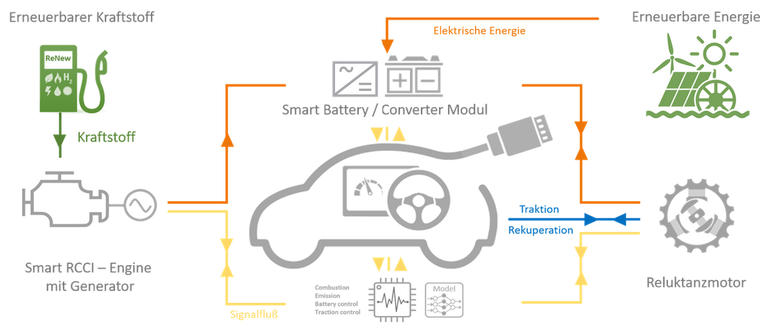Forschungsschwerpunkte
1. Integrierte Entwicklung von Brennverfahren, Regelungsstrategien und Abgasnachbehandlungen für Ottomotoren
- Brennverfahren und Zündungskonzepte für den stöchiometrischen und mageren Betrieb mit Benzin und Gas (konventionelle Zündkerzen und Vorkammerbrennverfahren/ Vorkammerzündkerzen)
- Controlled Auto Ignition, Spark-Assisted Auto Ignition und Reactivity Controlled Compression Ignition Konzepte
- Aufladekonzepte und Ladungswechseloptimierung für stationäre und hochtransiente Anwendungen bei höchster Leistungsdichte
- Regelungskonzepte für höchsten Wirkungsgrad oder beste Transienten bei minimalen Emissionen
2. Hybridantriebe mit quasi-stationär betriebenen Ottomotoren
Konzepte für höchsten Wirkungsgrad und beste Transienten bei minimalen Emissionen
3. Methoden und Tools für die integrierte Entwicklung
- Indizierung, Brennverlaufs- und Landungswechselrechnung
- 0D/ 1D Verbrennungsmodelle für Benzin- und Gasmotoren
- 3D Simulation von ottomotorischer Verbrennung, Turbulenzemodelle, Zündungsmodelle, phänomenologische und reaktionskinetische Verbrennungsmodelle

Verknüpfung von Energieerzeugung und Antriebstechnologien
Beispiel 1: CO2 - Neutrale Universität

Beispiel 2: PHEV Konzept für CO2-neutrale Mobilität

Patente
2017
Internal combustion engine
Internal combustion engine comprising:
- a control device for controlling the internal combustion engine
- at least one piston-cylinder unit
- at least one of the at least one piston-cylinder unit and cylinder-individually lackable inlet valve
- at least one sensor for detecting a signal which is characteristic of a pressure present in the at least one piston-cylinder unit
The control device having a detection mode in which the at least one inlet valve of at least one piston-cylinder is shut off, and in that the control device is designed to detect the pressure detected in the detection mode in the piston-cylinder unit to compare the characteristic value with a reference value.
2015
Method for knock control
Method for knock control of an internal combustion engine with a least one cylinder to which at least one inlet valve is assigned. Whereby when knocking occurs in at least one cylinder by actuation of the cylinder identified as being knocking associated intake valve in such a way that the temperature of the charge of the recognised as knocking cylinder is lowered, the knocking in the cylinder is reduced.
Dual-fuel internal combustion engine
The invention relates to a dual-fuel internal combustion engine comprising a controller for controlling the internal combustion engine and at least two piston/cylinder units, each of which is paired with a fuel injector for a liquid fuel, said fuel injector having an injector needle that can assume different needle positions, and each of which is paired with a gas supply device for gaseous fuel. The controller is designed to actuate the fuel injector and the at least one gas supply device in an individual manner for selectively metering the quantity of liquid or gaseous fuel supplied to each of the at least two piston/cylinder units. For each of the at least two piston/cylinder units, at least one needle sensor is provided which is connected to the controller and is paired with the respective piston/cylinder unit. A signal which characterised the needle position in the ballistic quantity in the ballistic region in an individual manner for each of the at least two piston/cylinder units.
2014
Operational method for spark ignition engine
Problem to be solved: To provide a spark ignition engine capable of performing high performance combustion and simultaneously reduction of discharge, and an operation method therof.
Solution: This invention comprises some steps for forming combustible mixture by substantially equal quantitative manner the first fuel and air and feeding the mixture into at least one cylinder during an intake stroke; compressing the combustible mixture with a piston during a compression stroke to feed a part of the combustible mixture into a pre-combustion chamber; and feeding the second fuel into the pre-combustion chamber at the time of feeding before starting combustion during intake stroke and/or compression stroke, the second fuel having the same or different chemical composition and/or concentration as that of the first fuel, and further stage for spark igniting in the pre-combustion chamber, and an amount of the second fuel fed into the pre-combustion chamber and/or the chemical compostion of the second fuel and/or an ignition time at the pre-combustion chamber and/or a temperature of substance poured into the cylinder is selected in such a way that a desired combustion period can be attained.
Method for operating a spark ignited engine
A method includes forming a combustible mixture by mixing generally homogeneously a first fuel and air and introducing this mixture into a cylinder, compressing the combustible mixture with a piston in a compression stroke, introducing a second fuel into a prechamber at an introduction-time before start of combustion thus creating a prechamber charge in which the second fuel being the same or different chemical composition and/or concentration with respect to the first fuel, and sparking igniting the prechamber charge. Emission of the cylinder and/or mechnical stress of the cylinder caused by the combustion are monitored. If emissions and/or mechanical stress are above respective predetermined thresholds, individually for the at least one cylinder, the chemical composition and/or the amount of second fuel introduced into the prechamber, and/or temperature of the cylinder charge and/or spark time, are changed.
Method for operating a compression ignition engine
A method for operating a compression ignition engine includes forming a combustible mixture by mixing generally homogeneously a first fuel and air and introducing this mixture into the at least one cylinder, compressing the combustible mixture with the piston in a compression stroke, injecting a second fuel to the combustible mixture at an injection-time of the second fuel during the compression stroke but before start of combustion, and continuing the compression stroke until combustion starts at those locations in the at least one cylinder where the concentration of the second fuel is highest and/or the temperature of the mixture is the highest. Emission of the cylinder and/or mechnical stress of the cylinder caused by the combustion are monitored, and if emissions and/or mechanical stress are aboce respective predetermined thresholds, individually for the cylinder, the amount and/or the timing of the second fuel injected, and/or temperature of the cylinder charge is changed.
Method for operating a combustion engine
Die vorliegende Erfindung ist auf ein Verfahren zum Betreiben einer Brennkraftmaschine mit den Merkmalen des Oberbegriffs von Anspruch 1 und auf eine Brennkraftmaschine mit den Merkmalen des Oberbegriffs von Anspruch 6 gerichtet. Bei der Auslegung von Brennkraftmaschinen besteht ein Zielkonflikt bei der Reduktion verschiedener Arten von Emissionen wie Stickoxiden (NOX), unverbrannten Kohlenwasserstoffen (HC), Kohlenmonoxid (CO) und der Reduktion von Partikelemissionen (engl. particulate matter, PM). Ein vielversprechender Ansatz für eine Verbrennung mit hohem Wirkungsgrad und geringen Emissionen ist das sogenannte HCCI Konzept (Homogeneous Charge Compression Ignition). Hier erfolgt die Entzündung einer hochverdünnten (das heißt magergemischt und/oder mit einer hohen Abgasrückführrate) und homogenen Kraftstoff-Luft-Mischung durch den Temperaturanstieg während des Verdichtungsaktes nahe dem oberen Totpunkt. Die stark verdünnte Kraftstoff-Luft-Mischung erlaubt eine Verbrennung mit extrem geringen Werten von Stickoxiden (NOX).
2011
Laser Spark Plug
Laser spark plug, comprising a housing having an axial extension, a fastening section for fastening the housing in a cylinder head of an internal combustion engine and at least one pressure sensor, characterized in that one of mounting portion viewed in the axial extent of the housing spaced sealing sear is provided and that the at least one pressure sensor in the axial extent of the housing viewed between the sealing seat and the mounting portion is arranged.
2007
Method for modeling combustion process of internal combustion engine operating an Otto principle, involves modeling combustion process by superposition of two vibe-functions
The method involves modeling a combustion process by a superposition of two vibe-functions. The premixed area of the combustion is simulated by the former vibe-function. The diffusion-controlled area is simulated by the later vibe-function. A vibe-parameter of the former vibe-function and a vibe-parameter of the later vibe-function are independent from each other.
2006
Method for operating an internal combustion engine with variable valve training
Method for operating an internal combustion engine with variable valve train for actuating gas exchange valves (EV1, EV2, AV1, AV2) and an injection of fuel into a combustion chamber and/or a suction tube. The gas exchange valves (EV1, EV2, AV1, AV2) are opened in an intake stroke (ANS) so that a stratified charge is formed in the combustion chamber, wherein in a lower part of the combustion chamber substantially exhaust gas and in an upper part an ignitable mixture is present.